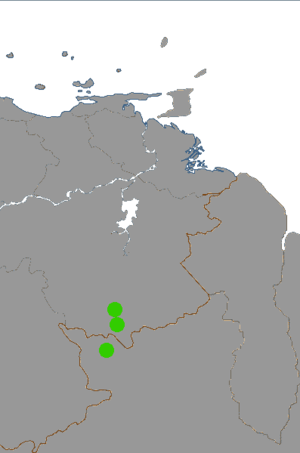Arutani–Sape languages
The Arutani–Sape, also known as Awake–Kaliana or Kalianan, are a proposed language family[1] that includes two of the most poorly documented languages in South America, both of which are nearly extinct. They are at best only distantly related, but Kaufman (1990) finds the connection convincing. However, Migliazza & Campbell (1988) maintain that there is no evidence for linking them.[2] The two languages are,
| Arutane–Sape | |
|---|---|
| Kalianan | |
| Geographic distribution | Brazil–Venezuela border |
| Linguistic classification | Proposed language family |
| Subdivisions |
|
| Glottolog | None |
 Documented location of Arutani–Sapé languages, the two most southern spots are Arutani villages, the northern one is Sapé location. | |
Kaufman (2007: 68) also adds Awaké to the family, a connection which had been proposed by Greenberg (1987).[3]
- Arutani[4] (also known as Aoaqui, Auake, Auaque, Awake, Oewaku, Orotani, Uruak, Urutani)
- Sape[5] (also known as Caliana, Chirichano, Kaliana, Kariana)
Kaufman (1990) states that a further connection with Maku of Roraima is "promising". (See Macro-Puinavean languages.)
Vocabulary
Migliazza (1978)
Migliazza (1978) gives the following Swadesh list table for Uruak, Sape, and Maku:[6]
no. gloss Uruak Sape Maku 1 I maykate/ma-/tsa- mɨ teːne 2 thou kaykate/ka- kapɨ eːne 3 we materya mɨyono teːkene 4 this kiʔa tɨsa ki 5 that ayta tɨsami kwa 6 who maʔayokə pante toči 7 what maya pemente čini 8 not ãʔãy atsam/ɨka laʔa 9 all kitate kawen peʔtaka 10 many kaʔtyaw kawen eːsuʔu 11 one kyoana/kyano koka nokuðamu 12 two komana kɨrya baʔta 13 big kwaya konən bote 14 long šawi karya kaxi 15 small sikipi to kudi 16 woman kari kapay neːlabə 17 man maʔkya kwa laːsəba 18 person kina kamon dzoʔkude 19 fish kotom pə meʔkəsa 20 bird yopsa čam iːduba 21 dog toari to dzoʔwi 22 louse koʔka čo iːne 23 tree šapi tapa oːba 24 seed kuka ku küːte 25 leaf aña muyra deːmu 26 root aša tu leːmekeči 27 bark kõhã kui/kuy čiːmu 28 skin kõhã kuy čːmu 29 flesh mitsa mɨan muči 30 blood kaña tsom leːme 31 bone mo wina aːmu 32 grease wiñaya kun eːkünü 33 egg kokama kupi küʔte 34 horn širipya wina eːkatso 35 tail mašya upi neːto 36 feather oša ičam upa kuːte 37 hair oša pa kuːte 38 head kwate moynaku keːte 39 ear watika awi čikaʔte 40 eye kohap amku sukute 41 nose wa/kwa ayku pi 42 mouth maʔa itu wɨːči 43 tooth ka pɨka wuːmu 44 tongue takõhã matu duːte 45 claw šopti ičam aypa sukuči 46 foot šate ikora basuku 47 knee korokopsa mɨney basəkate 48 hand maša/mama piča apa suku 49 belly tsya tukuy sɨkɨči 50 neck šoropaña pokoy lipite 51 breasts kotsa wi čüčü 52 heart kirakote pokowi səbuku 53 liver ika mapi iːsa 54 drink oyta/ayta pe mi 55 eat pa/kapa ko/ku ki 56 bite psa/pasa pu bü 57 see kina mow ku 58 hear ko man ne 59 know kina mow nimi 60 sleep anə paku/ku we 61 die atay siya kinə 62 kill rio (beat) kaya šipinu 63 swim ša pə lawa 64 fly šan karu nü 65 walk ma paru te 66 come mana ma na 67 lie down kio/taa pɨre ða 68 sit naka maye sɨkɨ 69 stand kara pa kəy 70 give matso emeyma se 71 say mataka/tsama mo šini/šibu 72 sun uši ñam keʔle 73 moon aʔtap tapo ya 74 star okihat ñayino ðaoku 75 water akohã nam naʔme 76 rain akohã nam posoe naʔme 77 stone muka takuypa liːne 78 sand iñãkosa inoku lunükü 79 earth iñã inokučin boʔte 80 cloud karapaso usəyna sapənawi 81 smoke šana yui čipe 82 fire ani šoko nühẽ 83 ash šoni tukutu meːte 84 burn asipa šoko we/niʔ 85 path aʔma mu iːkilu 86 mountain piʔa takwa wiːke 87 red araʔwi ayña leme 88 green atehe šanurua nüčü 89 yellow pišio pusia kaləmadə 90 white araway sae kaləmate 91 black sipan/soson tsaiña kabi/weʔči 92 night tose useyna iːkisu 93 hot kuri ɨrɨa we 94 cold roma/kima unkoya antsu/mihu 95 full topi ukwa suku 96 new koma yenkoña asi 97 good taseri amayñakoa kuduma/eːdi 98 round siari način kuməsa 99 dry šona patokwa kaːte 100 name rawi marua entse
Loukotka (1968)
Loukotka (1968) lists the following basic vocabulary items for Kaliána.[7]
gloss Kaliána one koki two ikiria three komoña head koyanukú eye kam-kukú tooth kaká man mínõ water inám fire txokó sun yám manioc téntu jaguar pudzyín house enaĩ
See also
| Wiktionary has Swadesh lists at Appendix:Arutani–Sape Swadesh lists |
Notes
- Weinstein, Jay A. (2005-02-28). Social and Cultural Change: Social Science for a Dynamic World. Rowman & Littlefield. p. 94. ISBN 0-7425-2573-2.
- Ernest Migliazza & Lyle Campbell, 1988. Panorama general de las lenguas indígenas en América
- Kaufman, Terrence. 2007. South America. In: R. E. Asher and Christopher Moseley (eds.), Atlas of the World’s Languages (2nd edition), 59–94. London: Routledge.
- Moseley, Christopher (2007-04-23). Encyclopedia of the world's endangered languages. Routledge. p. 177. ISBN 978-0-7007-1197-0.
- Moseley, Christopher (2007-04-23). Encyclopedia of the world's endangered languages. Routledge. p. 164. ISBN 978-0-7007-1197-0.
- Migliazza, Ernesto C. 1978. Maku, Sape and Uruak Languages: Current Status and Basic Lexicon. Anthropological Linguistics 20: 133-140.
- Loukotka, Čestmír (1968). Classification of South American Indian languages. Los Angeles: UCLA Latin American Center.